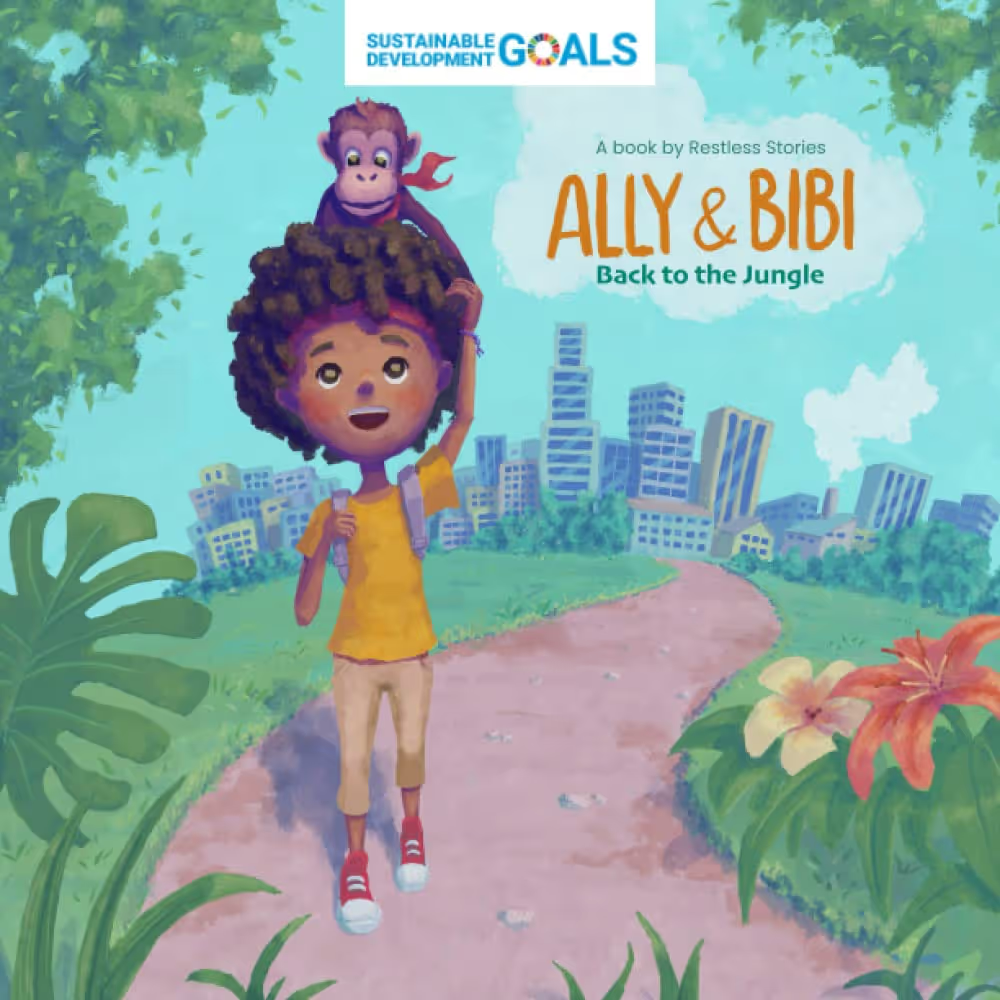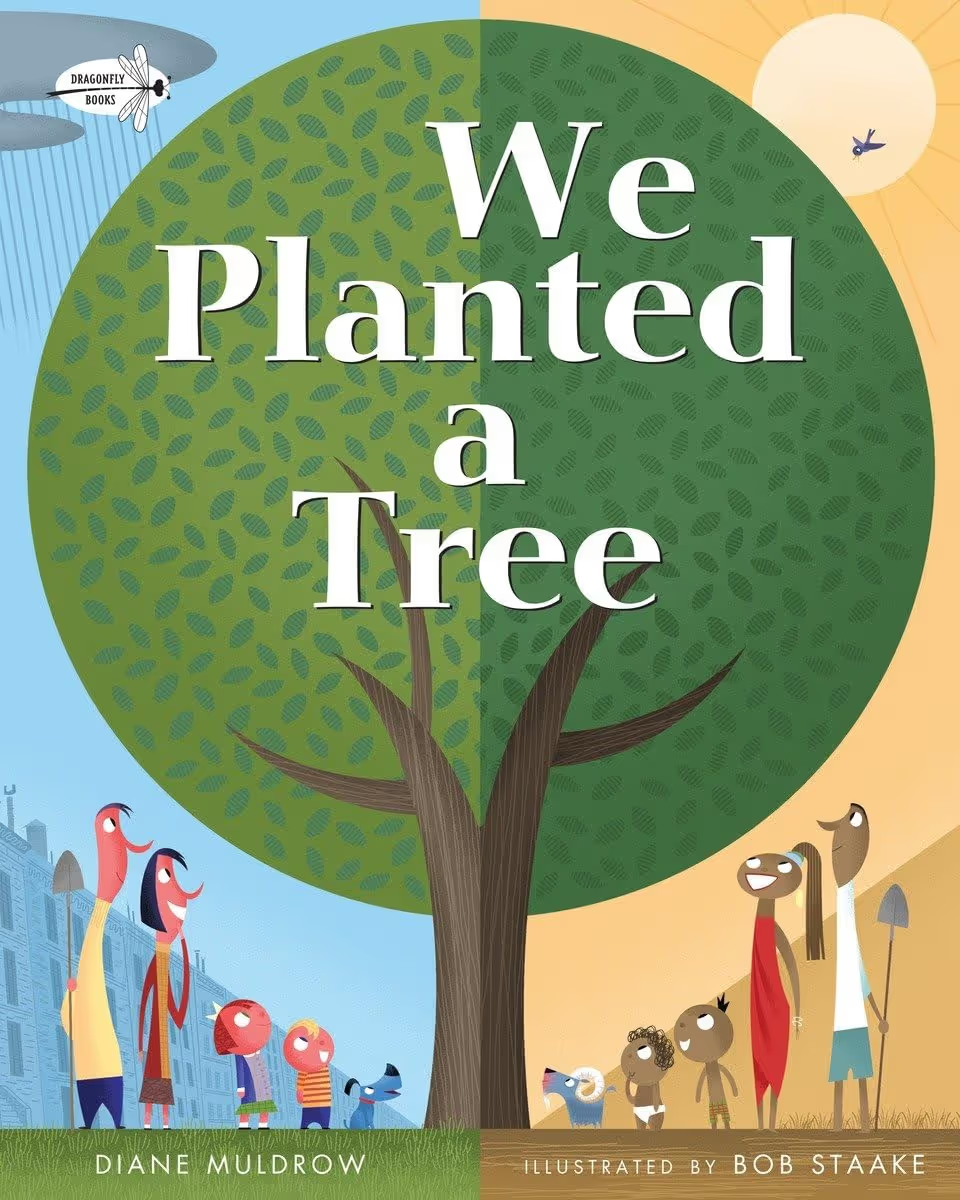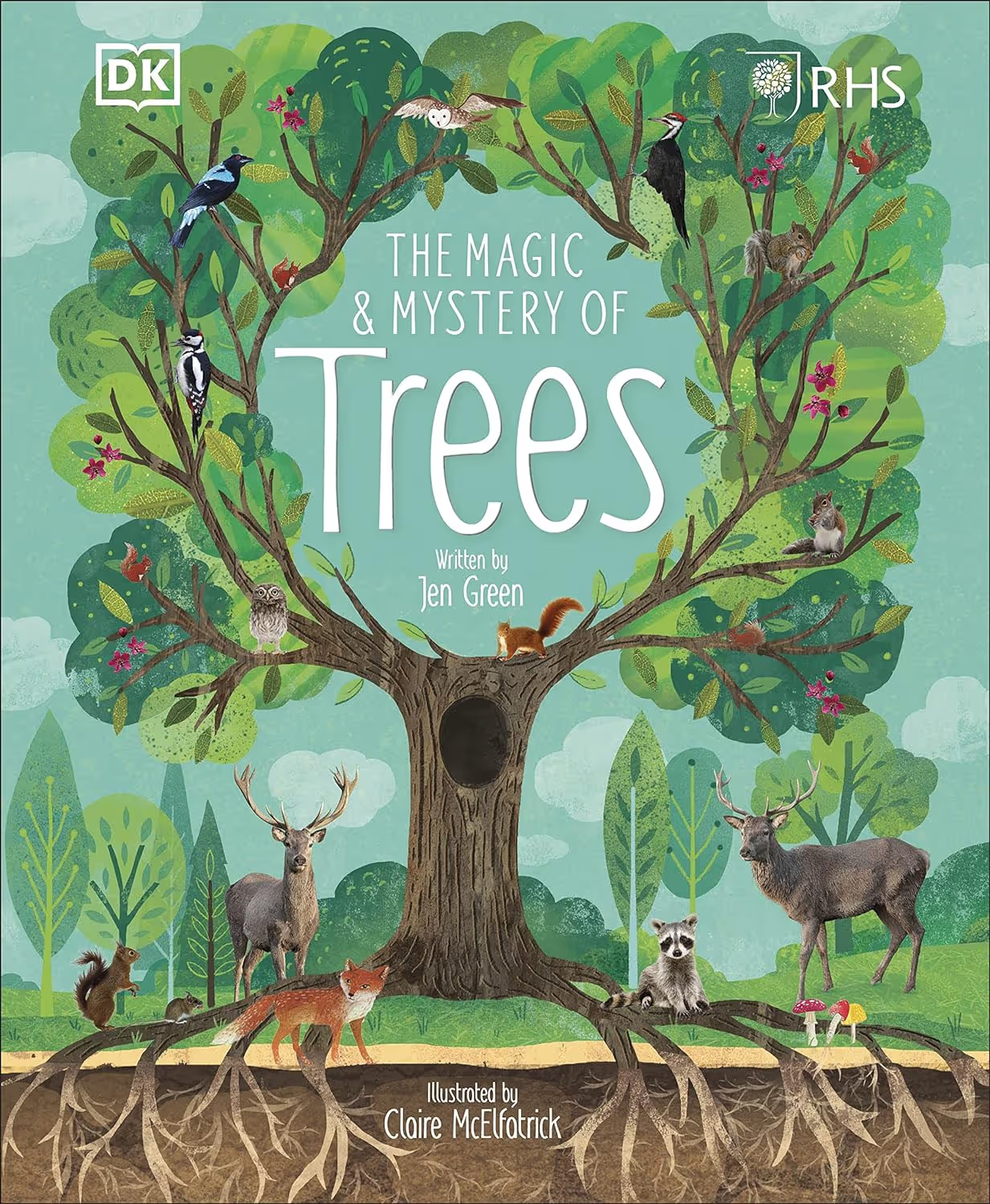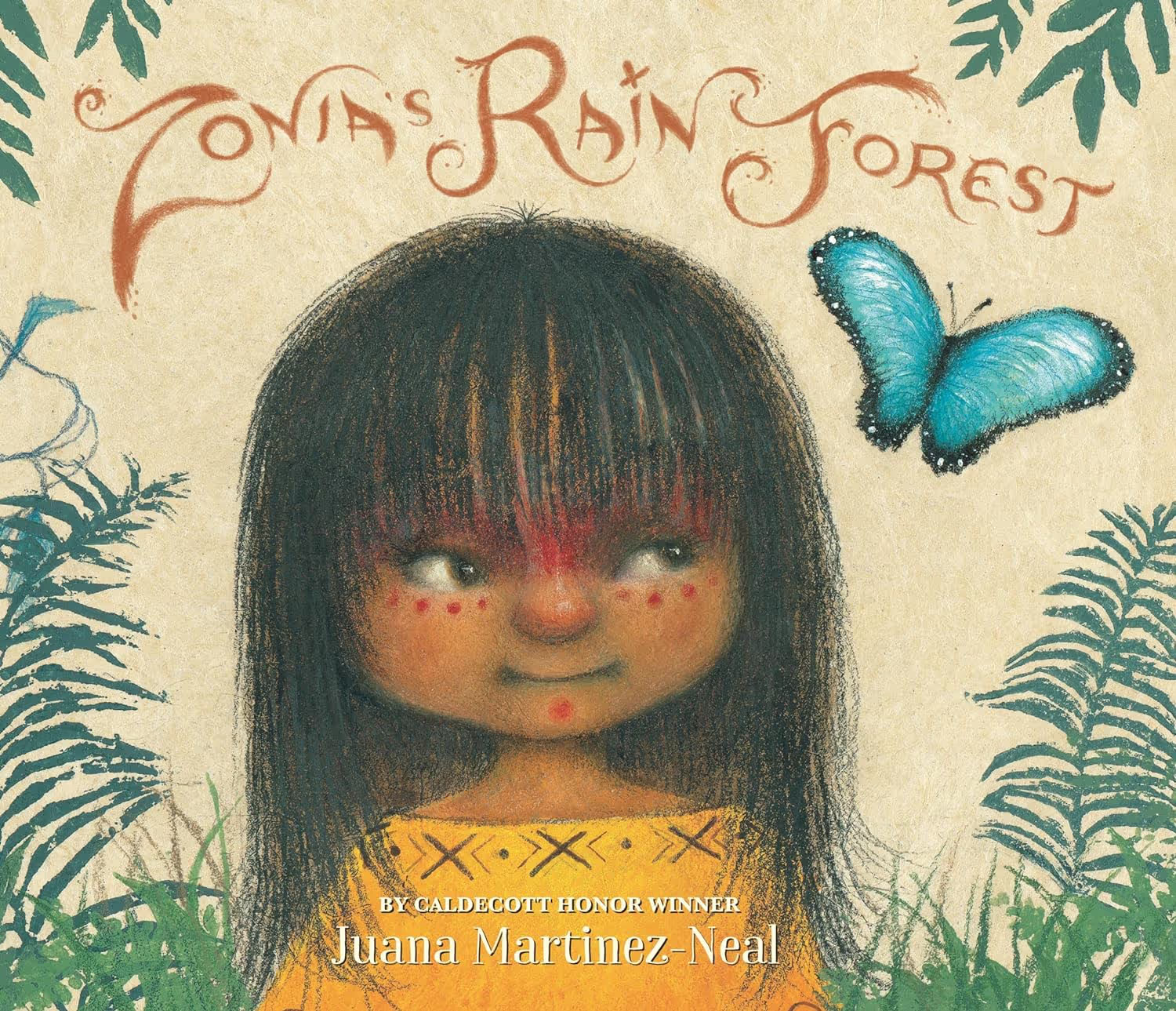In today's world, where climate change and environmental issues are at the forefront of our minds, it is crucial to educate our children about the importance of taking care of our planet.
Environmental education plays a vital role in shaping the minds of the younger generation and inspiring them to become caretakers of the Earth. One powerful way to introduce environmental topics to children is through literature.
Children's books about the environment not only educate but also inspire young readers to make a positive impact on their surroundings.
Where to start?
There are so many incredible kids' books that beautifully illustrate the wonders of the environment. Some also educate children on what we as a society must do to protect the glorious trees, organisms, and animals.
One example is our kid's picture book, Ally & Bibi: Back to the Jungle. It explores the challenges our planet is facing while also demonstrating the solutions that currently exist so everyone can continue to enjoy the environment in the future.
If you want to educate your children on the beauty of nature, we recommend choosing these ones for your next story time.
7 Kids Books About the Environment
Add these children’s books about the environment to your bookshelf.
1. Ally & Bibi: Back to the Jungle - Dario Berrebi
- Print Length: 45 pages
- Reading Age:
- Amazon Rating: 4.8 out of 5 (8 ratings)

When Ally is gifted a monkey named Bibi for her birthday, she chooses to take him back to his jungle home. But their adventure is far from simple, as they encounter the planet's pressing environmental issues and discover potential solutions to address them.
“Amazing book for my nephews and nieces! Such an educational gift! Love it,” said one reviewer.
2. We Planted a Tree - Diane Muldrow
- Print Length: 40 pages
- Reading Age: 3 - 7
- Amazon Rating: 4.7 out of 5 (150 ratings)

Two families in two different parts of the world plant trees. The story shares how these trees help produce cleaner air, deliver fruit, and provide shade. It celebrates their underrated lives while educating readers on the value they bring to the planet.
“This is a simple but powerful book that will leave lasting images in young minds. There is not much to read, and it's not the words but rather the concept and the pictures that strike,” a recent purchaser said.
3. Wonder Walkers - Micha Archer
- Print Length: 32 pages
- Reading Age: 3 - 7
- Amazon Rating: 4.7 out of 5 (193 ratings)

A couple of curious kids take a stroll and let their imaginations run wild. On their walk, they pose thought-provoking questions to one another, such as “Is the sun the world’s light bulb?” and “Are rivers the Earth’s veins?” The glorious collage illustrations are vibrant and powerful while providing readers with an inspiring adventure.
One reviewer shared, “I read it to every group of kids that I have, and every one of them is captivated by the words and illustrations.”
4. The Magic and Mystery of Trees - Jen Green
- Print Length: 80 pages
- Reading Age: 4 - 6
- Amazon Rating: 4.9 out of 5 (2,718 ratings)

Did you know trees can communicate with each other? How about they could warn others about predators? They can even record the past and anticipate the future to preserve themselves. This book unravels the mysteries of trees with amazing illustrations and interesting facts about these incredible organisms.
One reviewer said, “My kids absolutely love it, and when my daughter brought it into school for show-and-tell, the other kids' teachers loved it, too!”
5. Zonia’s Rain Forest - Juana Martinez-Neal
- Print Length: 40 pages
- Reading Age: 4 - 8
- Amazon Rating: 4.8 out of 5 (132 ratings)

Zonia lives in the Amazon rainforest and has a special relationship with the trees and inhabitants. One day, the rainforest calls her for help, and Zonia rushes to save her friends. The illustrations feature rich details from the rainforest that will immerse your kids in the stunning environment.
“Beautifully illustrated and a lovely story, my niece and I really enjoyed meeting Zonia and following along as she said good morning to her forest friends,” said one recent reader.
6. The Coral Kingdom - Laura Knowles and Jennie Webber
- Print Length: 32 pages
- Reading Age:
- Amazon Rating: 4.7 out of 5 (23 ratings)

Get a close-up view of the colourful coral reef and its inhabitants of various fish species. The story shares the story of the life cycle and colour of the coral reef ecosystem, using rhyme and poetry to deliver its message. It also includes beautiful artwork that feels like it leaps off the page.
One reviewer wrote, “The rhyme flows beautifully through the stunning illustrations explaining why the coral is so important and why we need to take care of it.”
7. Lily and the Polar Bears - Jion Sheibani
- Print Length: 32 pages
- Reading Age: Up to 5 years
- Amazon Rating: 4.7 out of 5 (26 ratings)

While Lily plays on the beach, some polar bears show up after floating on the ocean. Naturally, she invites them to stay with her, and together, they go on a series of adventures ranging from ice skating to spending a day at the fair.
One reviewer shared, “Our children ADORE this book! Such beautiful and charming illustrations and a story with some important messages.”
Best ways to teach children about the environment
Teaching children about the environment effectively involves utilising best practices and behavioural techniques grounded in educational psychology. This approach helps foster environmental awareness, knowledge, and sustainable behaviours from an early age.
Evidence-based education (full references at the end)
- Active engagement and experiential learning:
- Engaging children in hands-on activities such as gardening, recycling, and field trips significantly enhances their understanding and retention of environmental concepts. Practical experiences in nature help children connect with the environment and develop sustainable behaviours.
- Incorporating field experiences, such as forest adventures, can foster knowledge, positive attitudes, and advocacy for environmental conservation.
- Integrating environmental education in the daily curriculum:
- Embedding environmental education into the daily curriculum and using the classroom environment as a learning tool can significantly impact children’s attitudes towards sustainability. This includes practices like waste minimisation, energy conservation, and using nature-related themes in teaching materials.
- The Reggio-Emilia approach, which provides various nature-related experiences, has been shown to foster environmental attitudes and behaviours in children.
- Developing critical literacy and reflective skills:
- Using the environment as a text to develop critical literacy skills helps children understand and care for their surroundings. This approach involves activities that encourage children to observe, analyse, and reflect on their environment, promoting a deeper connection and respect for nature.
- Encouraging children to engage in reflective practices about their environmental experiences can strengthen their connection to nature and foster a caring attitude towards the environment.
- Use of play-based pedagogies:
- Play-based learning strategies are effective in teaching young children about complex environmental concepts. Activities such as role-playing, storytelling, and games that incorporate environmental themes can make learning enjoyable and impactful.
- Designing nature-based excursions and outdoor learning experiences can significantly influence children's attitudes and behaviours towards the environment.
Stories That Inspire Environmental Protection - by Age Group
Stories can be a powerful way to encourage children to care for the environment. Tailoring narratives to their developmental stages ensures that they connect deeply with the message. Here’s how to approach storytelling by age group:
For Preschoolers (Ages 3–5): Simple and Interactive
- Animal Adventures: Stories where animals face challenges due to environmental changes, such as a bird searching for a clean home.
- Picture Books: Use books with vibrant illustrations showing the beauty of nature and simple actions kids can take to help.
- Interactive Storytime: Stories where children participate, like mimicking the sounds of animals or choosing solutions for problems, make environmental concepts relatable.
For Early Primary School (Ages 6–8): Explorative and Fun
- Nature Detectives: Tales where young characters investigate and solve environmental problems, like finding out why a river is polluted.
- Heroic Stories: Narratives of kids planting trees or rescuing animals inspire them to emulate positive actions.
- Short Chapter Books: Age-appropriate fiction with relatable protagonists working to protect their local environment.
For Late Primary School (Ages 9–12): Problem-Solving and Empowering
- Real-Life Inspirations: Stories based on true accounts of young activists, like those organising clean-up drives.
- Adventure Narratives: Stories that combine environmental themes with exciting adventures, such as exploring endangered forests.
- Interactive Digital Tales: Choose-your-own-ending stories where decisions affect the environment and teach cause-effect relationships.
For Teenagers (Ages 13–18): Thought-Provoking and Activist-Oriented
- Dystopian Futures: Stories set in a world affected by environmental neglect encourage reflection on current habits.
- Young Activist Tales: Narratives showcasing teens making significant impacts on their communities, such as leading climate marches or inventing sustainable solutions.
- Cultural and Historical Perspectives: Stories connecting environmental issues with cultural practices or historical events foster deeper understanding and empathy.
The Role of Literature in Environmental Awareness
Literature has the power to transport us to different worlds, allowing us to experience life through the eyes of diverse characters. When environmental themes are interwoven into compelling stories, children not only learn about nature but also develop a sense of empathy towards the environment and its inhabitants.
By exploring various environmental issues through literature, children can gain a deeper understanding of their impact on the planet.
Another example of literature that raises environmental awareness is the novel "Hoot" by Carl Hiaasen. This book tells the story of a group of children who take a stand against the destruction of a burrowing owl habitat.
Through the characters' actions and struggles, young readers learn about the importance of protecting endangered species and the impact of urban development on wildlife.
By incorporating environmental themes into literature, authors have the power to inspire young readers to become advocates for the environment. Through engaging narratives and relatable characters, children can develop a strong connection to nature and a desire to protect it.
Conclusion
Best practices for teaching children about the environment include active engagement in hands-on activities, integrating environmental themes into the daily curriculum, developing critical literacy skills, and using play-based pedagogies.
These approaches help foster a deep connection with nature and promote sustainable behaviours.
Understanding the Importance of Environmental Education
The role of environmental education in shaping the future cannot be overstated. By teaching children about the environment, we empower them to make informed decisions that will impact their lives and future generations. Literature, in particular, plays a significant role in raising environmental awareness among children. It presents concepts in an accessible and engaging manner, capturing their imagination and curiosity.
When children are exposed to literature that explores environmental themes, they are transported to different worlds, allowing them to experience life through the eyes of diverse characters. These stories not only teach them about nature but also develop a sense of empathy towards the environment and its inhabitants. By reading about the challenges faced by fictional characters in their interactions with the environment, children gain a deeper understanding of their own impact on the planet.
One example of literature that raises environmental awareness is the classic children's book "The Lorax" by Dr. Seuss. Through the story of the Once-ler and the Lorax, children learn about the consequences of deforestation and the importance of preserving natural resources. The colorful illustrations and rhyming text captivate young readers, making them eager to learn more about environmental issues.
Benefits of Introducing Environmental Topics Early
The earlier we introduce children to environmental topics, the more likely they are to develop a lifelong connection with nature. Early exposure to environmental concepts helps children develop an appreciation for the natural world and instills a sense of responsibility towards caring for it.
By starting conversations about the environment at a young age, we can nurture a generation of environmentally conscious individuals who will actively work towards creating a sustainable future.
When children are introduced to environmental topics early on, they have the opportunity to develop a deep understanding of the interconnectedness of all living things. They learn about the delicate balance of ecosystems and the importance of preserving biodiversity. This knowledge empowers them to make informed choices in their daily lives, such as reducing waste, conserving energy, and supporting sustainable practices.
Furthermore, early exposure to environmental education can spark a passion for environmental science and conservation in children. It can inspire them to pursue careers in fields such as ecology, environmental engineering, or wildlife conservation. By nurturing their interest from a young age, we can cultivate a new generation of environmental leaders who will drive positive change.
Age-Appropriate Environmental Books for Kids
To cater to different age groups, environmental books for children are available in various formats. Whether you have a young reader who enjoys picture books or an older child who prefers non-fiction, there are countless options available to inspire young minds.
Picture Books for Younger Readers
Picture books are an excellent way to introduce environmental concepts to younger readers. Books like "The Lorax" by Dr. Seuss and "Here We Are: Notes for Living on Planet Earth" by Oliver Jeffers beautifully illustrate environmental themes with captivating visuals that capture a child's imagination.
Chapter Books for Intermediate Readers
As children grow older, they can engage with more complex environmental topics through chapter books. "Hoot" by Carl Hiaasen and "Flush" by Carl Hiaasen tackle environmental issues through exciting narratives and relatable characters, sparking thoughtful discussions among readers.
Non-Fiction Books for Older Kids
For older kids who crave factual information, non-fiction books provide valuable insights into complex environmental issues. Titles like "Plastic Ahoy!: Investigating the Great Pacific Garbage Patch" by Patricia Newman and "The Boy Who Harnessed the Wind" by William Kamkwamba offer real-life stories and scientific explanations, empowering young readers to make informed decisions.
Reading Time and Discussion
After reading an environmental book, set aside time for a thoughtful discussion. Encourage children to share their thoughts, ask questions, and express how the story impacted them. By creating a safe space for dialogue, we can deepen their understanding of the messages conveyed in the books.
Related Activities and Projects
Extend the learning beyond the pages of a book by engaging children in related activities and projects. Planting trees, creating recycled crafts, or organizing a neighbourhood clean-up are just a few examples of hands-on activities that reinforce the importance of environmental stewardship.
Encouraging Further Reading and Exploration
After introducing children to environmental books, encourage them to explore further. Provide them with a list of recommended books, documentaries, or websites that delve deeper into environmental topics. This will foster their curiosity and inspire a lifelong love for learning about the environment.
As caretakers of the Earth, it is our responsibility to equip the next generation with the knowledge and passion to protect our planet. By introducing children to the top 10 kids books about the environment, we can inspire them to become active participants in creating a sustainable future. Let us open the doors to a world of imagination and discovery through literature, empowering our children to make a positive impact on the world around them.
Discover "Ally & Bibi's Wild Eco-Adventure"
As we turn the final page on our exploration of environmental children's literature, we invite you to embark on a unique journey with Restless Stories' own creation, "Ally & Bibi: Back to the Jungle."
This captivating children's book weaves the United Nation's Sustainable Development Goals into an exciting adventure, making complex concepts accessible and engaging for both children and their parents.
Through Ally and Bibi's heartwarming quest across a fictional Brazil, readers will encounter vivid storytelling and visuals that ignite emotion and connection to our planet's social and environmental challenges.
Perfect for nurturing young advocates for a sustainable future, Check out "Ally & Bibi's Wild Eco-Adventure" and take the first step towards inspiring impactful action in the comfort of your own home.
References
- Witt, S., & Kimple, K. P. (2008). 'How does your garden grow?' Teaching preschool children about the environment. Early Child Development and Care, 178, 41-48.
- Gambino, A., Davis, J. M., & Rowntree, N. E. (2009). Young Children Learning for the Environment: Researching a Forest Adventure. Australian Journal of Environmental Education, 25, 83-94.
- Davis, J. M. (2010). Young Children and the Environment: Introduction.
- Omidvar, N., Wright, T., Beazley, K., & Séguin, D. G. (2019). Examining Children’s Indoor and Outdoor Nature Exposures and Nature-related Pedagogic Approaches of Teachers at Two Reggio-Emilia Preschools in Halifax, Canada. Journal of Education for Sustainable Development, 13, 215-241.
- Chambers, J. M., & Radbourne, C. (2015). Developing critical literacy skills through using the environment as text. Language and Literacy, 17, 1-20.
- Kopelke, D. (2016). Environmental education through listening to children. Environmental Education Research, 22, 460-461.
- Edwards, S., Moore, D., & Cutter-Mackenzie, A. (2012). Beyond "Killing, Screaming and Being Scared of Insects": Learning and Teaching about Biodiversity in Early Childhood Education.
- Ballantyne, R., & Packer, J. (2002). Nature-based Excursions: School Students' Perceptions of Learning in Natural Environments. International Research in Geographical and Environmental Education, 11, 218-236.
- Dewi, N. (2017). People and nature in Asian stories: Reading and writing materials for eco-education. Retrieved from Petra University
- Mackey, G. (2012). To know, to decide, to act: The young child’s right to participate in action for the environment. Environmental Education Research.
- Sobel, D. (1996). Beyond Ecophobia: Reclaiming the Heart in Nature Education. Retrieved from Kinder Nature.
- Chawla, L. (2007). Education for strategic environmental behaviour. Environmental Education Research.
- Louv, R. (2008). Last Child in the Woods: Saving Our Children from Nature-Deficit Disorder. Algonquin Books.
- Hart, R. A. (2013). Children’s Participation: The Theory and Practice of Involving Young Citizens in Community Development and Environmental Care. Taylor & Francis.
- Monroe, M. C. (2003). Two avenues for encouraging conservation behaviours. Human Ecology Review. Retrieved from JSTOR.
- Ginsburg, J. L., & Audley, S. (2020). Beliefs and barriers to sustainability education in early childhood. Retrieved from Smith College.
- Lin, C. I., & Li, Y. Y. (2018). Protecting life on land and below water: Using storytelling to promote attitudes toward animals. Sustainability. Retrieved from MDPI.
- Cornell, J. (1979). Sharing Nature with Children: The Classic Parents’ and Teachers’ Nature Awareness Guidebook. Retrieved from ERIC.




.webp)
.webp)

